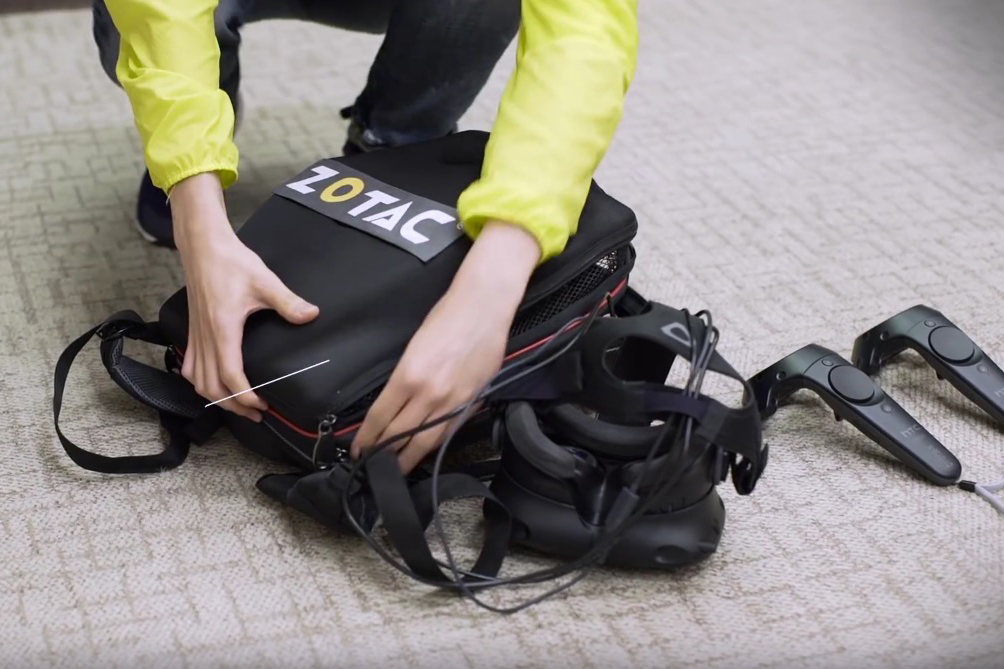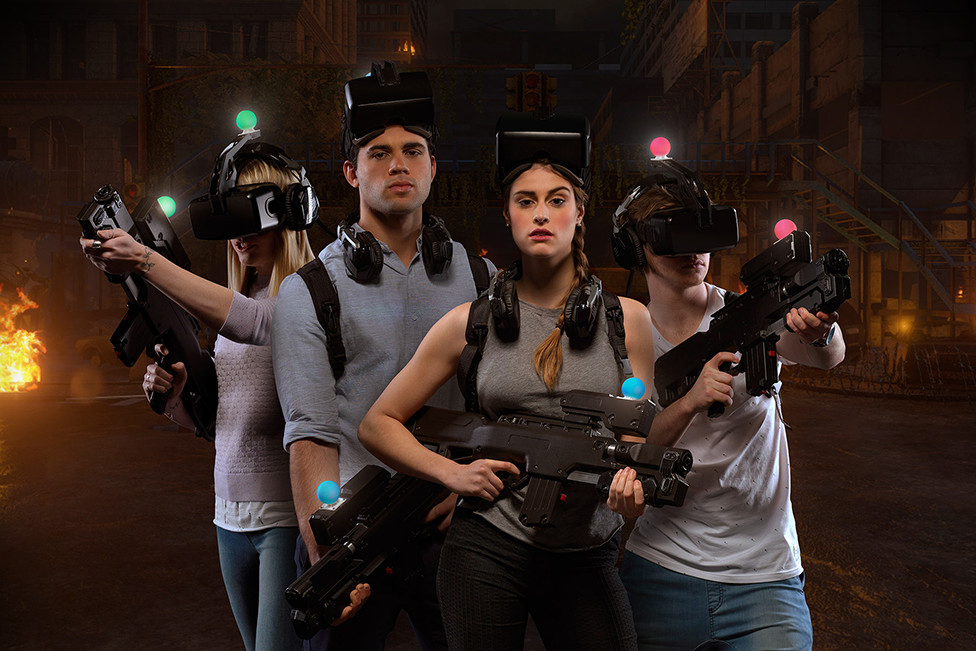The first generation of virtual reality (VR) headsets was some of the most exciting technology released this year, and there are big differences between the major players. But one thing unites all the high-end headsets — They’re tethered.
The reason VR headsets have yet to ditch the quite substantial cables is because comfort in virtual reality is very dependent on latency. If a frame generated by a graphics card takes more than a few milliseconds to reach your eyeballs, and your actions in the real world aren’t reproduced in the virtual in a similarly short time, it can cause disconnection and nausea. Wireless connections just aren’t reliable enough to meet the demands of VR.
Yet people still want to enjoy VR — espically in HTC’s Vive — without being tethered.
That’s why a number of manufacturers have recently debuted designs for backpack PCs. By taking the PC with us, it won’t matter that VR headsets are wired. In theory, at least.
The Void, Ghostbuster’s Dimension, Zero Latency
If anyone deserves credit for minting the idea of backpack VR, it’s The Void, a firm out of Utah which is designing and building a system far beyond the roomscale tracking of home VR setups. Using its own Rapture headset, tracking system, sensor/motor vest, and backpack system, it is going for an ultra-high-end experience that cannot be replicated in the home. It’s using this technology in an upcoming Ghostbusters attraction that lets you zap ghosts with your very own proton pack and ghost trap.
VR backpacks are ultra-portable, making them perfect for LAN gamers.
Zero Latency is a company doing something similar, but in Australia, where it has previously deployed Oculus Rift DK2s, Move Motion controllers, and backpack PCs to deliver an untethered VR experiences. It’s received a boost by teaming up with Sega to produce a zombie attack experience in Tokyo using its tech.
Because of the scale of the experiences The Void and Zero Latency are putting together, it makes complete sense that they’d look to do away with the wires of old. While wireless tracking systems are used to monitor player position, the VR image itself must be delivered through wires to a headset, which means carrying the PC with you.
The Void hasn’t been particularly vocal about what sort of hardware is inside the backpack, but it looks hefty enough that it could be more than just a gaming laptop with a mobile GPU – there’s certainly enough space for desktop performance hardware.
Considering how both companies have provided customers with extra hardware to carry around, like the headset itself, the vest system and their weapons and items, weight is obviously important. But the rigs they have equipped people with don’t seem to be too debilitating.
Nor should they be. The actual hardware inside a modern PC is light, weighing just a few pounds. The battery is more likely to be problematic. Endurance is a concern, but a bigger battery weighs more. However, these experiences have clearly defined time limits, so as long as staff can switch out the batteries for the next customers, this is unlikely to cause issues.
In this scenarios, backpack PCs are a great way to achieve the freedom large scale VR experiences require. Power, weight and battery life don’t seem likely to cause problems for the staff or the customers, and costs are less problematic because the companies charge a significant sum for each ticket.
But what about when it comes to those looking to try a backpack PC at home? Surprisingly, many companies are getting in on that action.
Alienware, MSI, Zotac, HP
Several manufacturers have their own takes on what a backpack PC should look like. Their internal hardware is similar across the board, with the GTX 980 being a popular choice, usually paired with an Intel Core i7 CPU, and hooked up to one or two large batteries to give you an extended period within virtual reality.
Of course, as with most high-end gaming laptops though, once you start performing intensive tasks, you don’t get a whole lot of time with them, but that’s a problem of battery technology more than anything else.
The most advanced we’ve seen is MSI’s, which sports the above hardware in a hot-rod-red chassis that doesn’t look too dissimilar to your average portable gaming system. However, the one area where it does stand out are the pair of straps that sit on its rear. That’s where it hooks up to the user, and though it’s hard to judge scale from static shots, images from TechRadar giving it a try on the show floor demonstrate just how compact the little system is. It’s said to weigh in around 12 pounds and though the tester said it tends to sit a bit too low on the back, it didn’t prove too taxing to maintain for the short demo period it was used for.
Zotac has been teasing its idea of a backpack gaming PC for a few months now, but it’s not quite as sturdy as what MSI has created. Essentially it’s a PC in a bag, with the company using its Zbox system in a backpack configuration to deliver the same functionality.
You would imagine that Zotac would be quite a good fit for this sort of system, as it’s been building Zboxes for years, and has experience with this sort of micro-system. Digital Trends’ senior editor Matt Smith tried Zotac’s option at Computex 2016 and found that the fabric construction, though not attractive, has benefits. It was light, feeling no more burdensome than a regular backpack with a 15-inch laptop inside (the actual hardware was, in fact, much smaller than a 15-inch laptop).
Like MSI’s offering, Zotac purports to offer between an hour and a half and two hours of play time.
HP’s design, known as the Omen X VR PC, is perhaps the most polished looking of the backpack systems we’ve seen. It also looks like a new product, rather than an old one bundled into a new form factor.
It’s very slimline, however, so when Ars got a look at the system it wasn’t sure whether a desktop graphics card would fit, or if it would be restricted to one of the MXM standard graphics processors instead. That wouldn’t be the end of the world in terms of out-of-the-box performance, since VR ‘only’ requires a GTX 970 or R9 290 to operate comfortably. But it would mean upgrading is out of the question.
One selling point it may have over the other offerings, is that its batteries are hot swappable. That means you should be able to game for longer, theoretically indefinitely if they charge up quickly enough.
Backpack PCs are a great way to achieve the freedom large scale VR experiences require.
Alienware’s offering is also understated, though it’s described as more of a concept than some of the other backpack VR systems we have looked at. The company says it’s being designed in tandem with Zero Latency, the Australian VR experience company we mentioned earlier in this article. However, what’s interesting to note with this system is that it’s a little underpowered compared to the competition. It comes fitted with a GTX 960 (a curious choice, since it’s below the threshold of recommended specifications for VR) or an RX 470.
Perhaps that’s because there are no real plans to make this a commercial product. The partnership with Zero Latency is not one way – Alienware has been providing hardware to the VR company for some time now. It may be that, because of the scenario played at Zero Latency’s facilities is optimized for the hardware available, high-end solutions aren’t required.
Dreaming of a cable-free future
The most important benefit is the obvious one. There’s no cable. It doesn’t drag under your feet, or become twisted and rub against your neck. Making it impossible for you to stand on a cable means there’s much less chance of you damaging it. That makes it a good choice for demoing VR, though perhaps not representative of what most home setups will be able to offer.
With VR already expensive, it’s hard to imagine people shelling out the more than $1,000 such systems will cost when made available to the public, on top of an $800 Vive headset. The fact that AMD has made such a big push to bring down the cost, rather than up the power, with its next-generation Polaris GPUs suggests that cost is a major limiting factor of virtual reality. Backpack PCs could be a tough sell if their only major feature is that they allow you to ditch the cables from your VR rig.
But limiting to that is forgetting the best part about these systems — they’re ultra-portable. They’re so portable you don’t need a backpack or carry handle for them – all of that is built in. These sorts of systems would be perfect for a LAN gamer.
If you regularly hoof your desktop and monitor (and a nice ergonomic chair if you value your spine) to LAN parties, then you are no doubt aware of the struggle that is often involved. Being able to throw your PC on your back makes for a much easier way to transport your system from the car park to your gaming station.
You could even imagine something like this being taken on a plane or train as a carry on and used for some VR gaming while on the move. We’re not sure how your fellow passengers would respond, but it’s possible. People already use the Samsung Gear VR on planes.
Back to reality
While it seems backpack gaming PCs could have interesting uses for those who want a truly self contained VR system, or those who are constantly on the move and want to take their PC with them, I must admit it’s hard to imagine this idea catching on.
Why? Because it’s designed to fix a problem that’s temporary. There is already talk of wireless headsets in the works, with the likes of AMD and Google both helping develop different VR hardware that is untethered from a PC or smartphone. And there are new, lower latency, higher-bandwidth technologies coming to wireless networking.
It’s not hard to imagine an Oculus Rift CV2, or Vive second edition, with a wireless connection to a PC.
There are some other advantages, and those will still be valid a few years from now. I think that virtual reality backpack PCs are going to be great for a few deep-pocketed enthusiasts in the short term, but ultimately supplanted before they can truly become common place.
Perhaps if we’d had a reason to use backpack PCs a decade ago, they would have had some life as they shrunk down and battery life increased, but at this stage wearable and portable computing isn’t far enough behind desktop hardware for backpack desktops to be a viable future.




